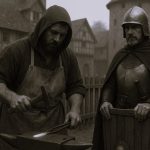
Throughout the centuries, a number of coal miners have documented their lives with paintings. Some of their works are now in museums and bring the stories of the “pitmen” back to life.

By Dr. Diana Cooper-Richet
Chercheur au Centre d’histoire culturelle des sociétés contemporaines
Université de Versailles Saint-Quentin en Yvelines – Université Paris-Saclay
Introduction
Curiously, despite its dangers and mysteries, the subterranean world of coal mines has been a subject of interest to a number of great artists, including Vincent Van Gogh, Theophile Steinlen, Constantin Meunier, Lucien Jonas and Manuel D’Rugama, whose magnificent Genesis Minero (1979) adorns the city hall of El Oro de Hidalgo in Mexico.

Even more intriguing, despite the difficult and exhausting lives that the miners led, a few of them found the inspiration and strength to depict their world in paintings. Some of their works have even made it into museums, both in Britain and in Japan.
Miners and Self-Taught Painters
A notable example of what is now known as the Ashington group. Its story began in 1934, when the miners’ union in the small Northumberland town asked the local Workers’ Educational Association – an adult-education organisation founded in 1903 – to find them a professor of economics. As none was available at the time, the association instead suggested evening classes in “art appreciation” for workers who wanted to “improve themselves”.
The instructor was Robert Lyon, a professor at King’s College in Newcastle-upon-Tyne and an artist himself. He began by showing his students – most of whom lacked any significant knowledge of art – the works of the great Renaissance artists. He then decided to apply the principle that “anyone can paint”, and suggested that the miners choose the subjects of their own pictures.
In the small house that served as a classroom, the apprentice painters brought their work each week to discuss it with their fellow classmates. These manual labourers, most of whom had never touched a brush to canvas before, were soon hooked. Thanks to the patronage of art collector Helen Sutherland, they were able to travel to London, where they visited the Royal Academy of Art and the Tate Gallery and met with renowned artists. By 1936, the miners’ paintings, exclusively showing aspects of their daily lives, were exhibited in Newcastle, London and Edinburgh. In the 1970s their works were even displayed in China and Germany, and the pitmen painters were the subject of newspaper articles as well as radio and TV programs.
All the paintings of this small group of self-taught artists are now kept in the Woodhorn Museum in Ashington. The collection includes works by founding members John Dobson and John F. Harrison, as well as Oliver Kilbourn, probably the best known of all. His series “My Life as a Pitman” was exhibited in Nottingham in 1977.
This story of the extraordinary encounter between a group of coal miners and art gave rise in 1988 to an illustrated book by art critic William Feaver, Pitmen Painters: The Ashington Group 1934-1984, as well as to a play of the same name that premiered in Newcastle in 2007. It later ran in London at the National Theatre, on Broadway in 2010 and in Auckland, New Zealand, in 2011. The play was written by Lee Hall, best known for the film Billy Eliot (2000) – the story of the son of an English miner who, to the surprise and despair of all in his manly environment, becomes ballet dancer. A French version of the play was presented in Switzerland and France, most recently at the Théâtre 13 in Paris.
In Japan as Well
The life and work of Sakubei Yamamoto (1892-1984) are both more unexpected and even more extraordinary than those of the Ashington pitmen. From the age of 7 or 8 he worked as a “trammer”, hauling ore and materials in the mine, became a hewer at 15 and finally night watchman when he became too old to go down into the mines. Yamamoto worked for more than half a century for almost 20 different mining companies, mostly located in the Fukuoka region, which was on the northern tip of Kyüshü Island, the southernmost of the Japanese archipelago.
As a child he loved to paint and draw, and only returned to his pencils and brushes in 1957, when he was over 60. At the time Japanese mines were closing one after the other, and he was able to tell the story of the coal miners at the end of the Meiji era (1868-1912) and in the first decades of the 20th century.

He was a prolific artist, turning out some 700 paintings, mostly watercolours, 45 notebooks of traditional ink drawings, and about 50 manuscripts, notably annotated newspaper articles concerning mining disasters. The collection testifies to the brutality of the mining life, the poverty of the workers and their families, their personal lives, customs and superstitions, and their struggles for a better life. It is now preserved in Tagawa History and Coal Museum, founded in 1983 on the site of a former mine near Fukuoka.
In 1963, Sakubei Yamamoto’s drawings and their accompanying texts were published by the Coal Mines of the Meiji and the Taisho Eras Publication Committee. While their circulation was modest, an educational program aired on Japanese television in 1967, A Life, a Mountain of Rubble, and two volumes on his paintings were published in 1973. All this contributed to the worldwide recognition of this extraordinary artist and his work: In 2011, it was added by UNESCO to the Memory of the World Register.
Originally published by The Conversation, 01.16.2018, under the terms of a Creative Commons Attribution/No derivatives license.







